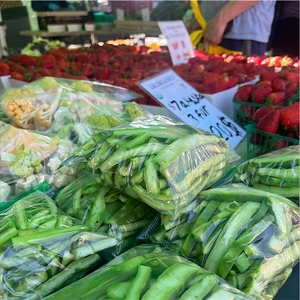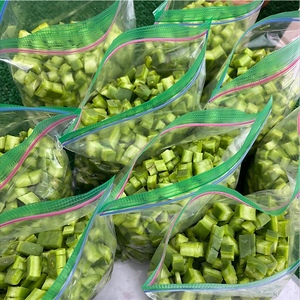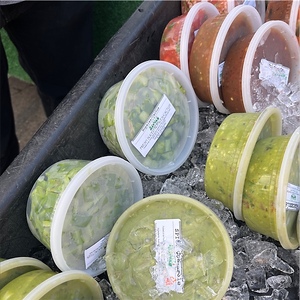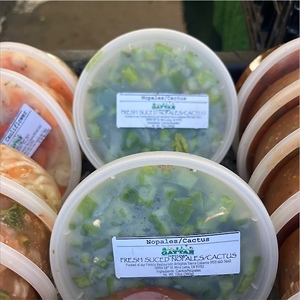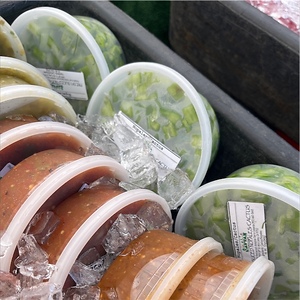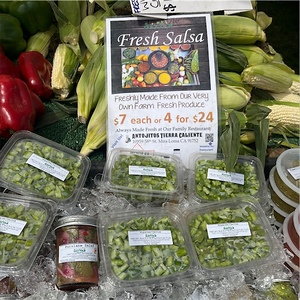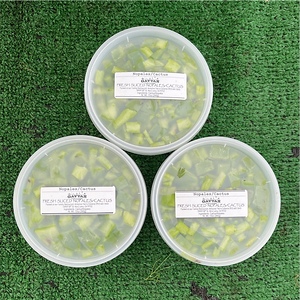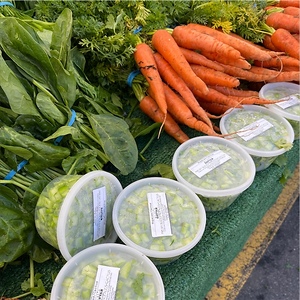


Nopales Cactus Leaf
Estimated Inventory, 30 lbs : 0
This item was last sold on : 05/30/25
Description/Taste
Nopales vary in size and shape, depending on the specific variety and age at harvest, but generally have a flat, oval appearance with tapered, curved edges. Each paddle is enveloped in a thick, firm, and taut skin with matte, bright green hues. The surface is covered in fine, sharp spines, which should be cleaned and removed before culinary use. It is recommended to only harvest young paddles as their spines are softer and less challenging to remove. When Nopales are sliced in half, their interior flesh is light green and contains a high liquid content. A mucilaginous gel is released from cut portions, creating a slippery texture. Select Nopales that feel firm to the touch and have a bright coloring. The paddles are edible raw or cooked and have a soft but slightly crisp consistency. Nopales are known for their fresh, green, and vegetal taste with a tangy, somewhat tart nuance.
Seasons/Availability
Nopales are available year-round, with a peak season in mid-spring.
Current Facts
Nopales, botanically a part of the Opuntia genus, are a category of various cactus species belonging to the Cactaceae family. It is estimated that over two hundred species of Opuntia are present in the Americas. The most common species in commercial markets under the Nopales name is Opuntia ficus-indica. Nopales is the term typically used for the plant’s fleshy paddles, also known as leaves. The plant, as a whole, is sometimes known as the Prickly Pear cactus. Throughout history, Nopales have been a traditional culinary and medicinal ingredient in Mexico and revered for their versatility and nutritional properties. Nopales are harvested when the paddles are young, soft, and less complicated to clean. The paddles are foraged from wild plants and cultivated for increased commercial availability. The firm leaves are favored for their vegetal, tart flavor and are incorporated into a wide array of fresh and cooked culinary preparations.
Nutritional Value
Nopales are a source of vitamins A and C to strengthen the immune system while maintaining healthy organ functions. The paddles also provide fiber to aid digestion and minerals, including magnesium, calcium, phosphorus, iron, manganese, and potassium. Magnesium controls nerve functions, calcium and phosphorus support bones and teeth, and iron develops the protein hemoglobin for oxygen transport through the bloodstream. Manganese assists the body in producing connective tissues, while potassium helps balance fluid levels and replenish electrolytes. In natural medicines throughout Mexico, Nopales paddles were heated and used as a warming press for aches and pains. The juice from the paddles was also used for its anti-inflammatory properties and slathered over burns and skin irritations.
Applications
Nopales paddles have a mild, green, and slightly tart flavor suited for raw and cooked preparations. The paddles are occasionally sold already prepped and cleaned, but if foraged, each paddle needs to be scraped with a knife to remove the needles. The edges should also be trimmed and peeled, and once scraped, the paddles should be run under water to ensure the surface is clean. It is important to note that when the paddles are sliced, they release a slippery, mucilaginous gel. This gel has a texture similar to okra and can be lessened if boiled. Nopales paddles are popularly chopped raw into salads, salsas, or used as a topping over tacos. The paddles can also be pickled as a tangy condiment or incorporated into smoothies and juices. In addition to fresh preparations, Nopales can be sautéed, grilled, roasted, steamed, and boiled. The paddles are often cooked with scrambled eggs, simmered into stews and soups, or served with refried beans. Try cooking Nopales with tomatoes, onions, and grilled meat or incorporating minced pieces into enchilada fillings. While less common, Nopales can be made into jams or used as a pizza topping. Nopales pair well with aromatics like garlic, onions, and shallots, herbs including cilantro, parsley, and epazote, and meats like poultry, beef, and pork. Fresh Nopales should be placed in a container lined with paper towels to absorb excess moisture and stored in the refrigerator for 2 to 3 weeks. They can also be frozen for six months.
Ethnic/Cultural Info
The Nopal cactus is famously featured in an ancient Aztec myth. Legend has it that the Aztec people had to flee their homeland of Aztlán. Some versions of the story say they were fleeing a tyrant, while other variations claim they were leaving in search of more fertile land. Huitzilopochtli, the Aztec god of the sun and war, told the Aztecs to create a new city where they saw an eagle sitting on top of a Nopal cactus with a serpent in its beak. The Aztecs wandered in the Valley of Mexico until they found Lake Texcoco, where they saw the famous bird of prey sitting on top of a cactus on an island in the middle of the lake. This area marked the new center for the Aztecs, and they dedicated the city and built a temple to Huitzilopochtli. They named the new city Tenochtitlán, a Nahuatl name roughly translating to “the place where the Nopal cactus grows from a stone.” In the modern day, this legend is illustrated on Mexico’s flag, which features the eagle, the Nopal cactus, and the snake. Nopales are called the “plant of life” in Mexico for their ability to grow in harsh environments and their multi-purpose use in culinary and medicinal applications. The plant can also grow a new plant from one fallen paddle, symbolizing rebirth and resilience.
Geography/History
Nopales are native to the Americas and have been growing wild since ancient times. There are many species found throughout the Americas with different origins, with a high number of species in Mexico. Indigenous American populations have been utilizing Nopales medicinally and culinary for thousands of years, and over time, the species has spread throughout the Americas through human intervention and cultivation. Nopales were documented in the 16th century, after the arrival of the Spanish, and the cactus was later introduced to other regions worldwide through Spanish explorers and trade routes. After its arrival globally, the cactus quickly naturalized, becoming an invasive plant in some regions. Today, Nopales are naturally growing worldwide and are being cultivated for commercial sale. The paddles and fruits are sold through farmers' markets, wholesalers, and select grocery stores.
Featured Restaurants
Restaurants currently purchasing this product as an ingredient for their menu.
| Olive Tree Marketplace | San Diego CA | 619-224-0443 |
| Cal A Vie | Vista CA | 760-945-2055 |
| The Shores | La Jolla CA | 858-459-8271 |
Recipe Ideas
Recipes that include Nopales Cactus Leaf. One








